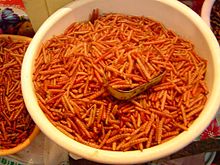Comadia redtenbacheri
| Comadia redtenbacheri | |
|---|---|
| Scientific classification | |
| Kingdom: | |
| Phylum: | |
| Class: | |
| Order: | |
| Family: | |
| Genus: | |
| Species: | C. redtenbacheri
|
| Binomial name | |
| Comadia redtenbacheri (Hammerschmidt, 1848)
| |
| Synonyms | |
| |
Comadia redtenbacheri is a moth in the family Cossidae. It is found in North America, where it has been recorded from Mexico and southern Texas.[1]
The length of the forewings is 12–14 mm for males and 13–16 mm for females. The forewings are brown with a white strip from the wing base to near the apex. The hindwings are grey-brown.[2] Adults have been recorded on wing from April to May and in September.[3]
The larvae feed on the succulent leaves of the maguey and Agave salmiana. Young larvae are pale reddish, becoming carmine in later instars.
In food and drink[]
The larvae are one of the species used to put into mezcal.[4] In Spanish, they are known as chilocuil, chinicuil, or tecol and have been traditionally used as food in Mexican cuisine. The caterpillars are also known as gusanos rojos, giving its name to a popular brand of mezcal; they are one of the two kinds of "worms" placed in bottles of mezcal, giving a unique color and flavor to the drink. The other, less appreciated ones, are the larvae of the agave snout weevil, Scyphophorus acupunctatus.[citation needed]
See also[]
References[]
- ^ Comadia at funet
- ^ Brown, R.M., 1975: A revision the North American Comadia (Cossidae). The Journal of Research on the Lepidoptera, 14 (4): 180–212. Full article: [1]
- ^ mothphotographersgroup
- ^ Bug Guide
External links[]
- Cossinae
- Edible insects
- Cuisine of Oaxaca
- Moths of North America
- Moths described in 1848
- Cossinae stubs
